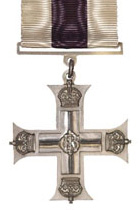Military Cross (MC)

Awarded for an act or acts of exemplary gallantry during active operations against the enemy on land, to captains or officers of lower rank up to warrant officers. (NCOs or other ranks instead received the Military Medal.)
First established
By King George V, 28 December 1914, ‘We are desirous of signifying Our appreciation of such services by a mark of Our Royal favour We do by these Presents for Us Our heirs and successors institute and create a Cross to be awarded to Officers whose distinguished and meritorious services have been brought to Our notice.’ (Gazette supplement 29024)
WW1 recipients
Cpt Francis Victor Wallington, RFA, gazetted 26 January 1917
Wallington was the first of four men in to be awarded the MC and 3 bars, first gazetted on 26 January 1917: ‘For conspicuous gallantry in action. He displayed great courage and skill during wire-cutting operations in preparation for the attack. Later, he brought a trench mortar forward to an exposed position under heavy fire.’ (Gazette supplement 29921)
First bar, 16 August, 1917: ‘For conspicuous gallantry and devotion to duty. He showed great coolness and courage under heavy shell fire on many occasions. A fire having broken out in a neighbouring battery's gunpits, he volunteered to extinguish it, which he succeeded in doing, working all the time under heavy shell fire.’ (Gazette issue 30234)
Second bar, 25 August 1917:
‘For conspicuous gallantry and devotion to duty in rushing to a dug-out in which men had been buried by shell fire and attempting to dig out the men, aided by two other officers. He himself was in a state of collapse, but insisted on helping to carry the wounded to a dressing station under shell fire.’ (Gazette supplement 30251)
He was invested with a third bar, which was gazetted on 10 July 1918 (Gazette supplement 30901):
‘For conspicuous gallantry and devotion to duty under close enemy machine-gun fire. This officer took forward two teams arid succeeded in moving off two guns. One of the teams was shot down, but he succeeded in bringing in the other gun. His gallantry and devotion to duty during recent operations was most marked.’
Wallington, of the Royal Field Artillery (RFA), was born in Woolwich, and later lived in Abingdon with his wife, Gwendoline, and 3 children. He survived the war and passed away aged 80, in 1971.
Only three other men were awarded the MC and three bars in WW1:
Dr Charles Gordon Timms, Lions rugby union player and lieutenant in the Royal Army Medical Corps, received the MC in July 1917 and 3 bars to follow for attending the wounded (MC Gazette supplement 30188, first bar 30813, second bar 13385, third bar 31158). He was also awarded an OBE in 1936 for actions in Somaliland (Gazette supplement 34296).
Lt Col Humphrey Arthur Gilkes HAC, soldier and doctor, intelligence officer and violin player, whose MC was awarded in September 1917 for ‘repeated reconnaissances under heavy fire, gaining valuable information and maintaining efficient communications throughout a period of several days.’ (MC Gazette supplement 30287, first bar 13218, second bar 30761, third bar 31158), during which ‘He showed magnificent daring and skill’.
Cpt Percy Bentley KOYLI (MC Gazette supplement 29886, first bar 30901) ‘showed great tact in moving the battalion to a position on the flank from which to launch a counter-attack, which was successful.’
Second bar, 7 November 1918 (Gazette supplement 30997) as his ‘untiring energy and his disregard of his own safety were conspicuous and worthy of high praise’.
Third bar (Gazette supplement 31158) ‘in spite of severe shelling, collected reports which enabled the defences to be reorganised. Later, he made another reconnaissance of great value. Throughout the operations lie was indefatigable, and showed great courage.’
Between world wars, Bentley was elected to serve as a Conservative representative on Pontefract Borough Council. He took a keen interest in the welfare of ex-servicemen and their dependants as a member of his local branch of the Royal British Legion.
